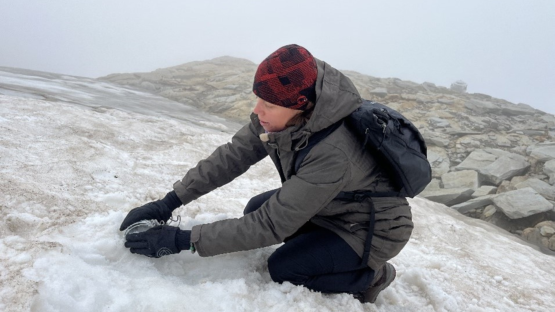The IAEA is launching a new Coordinated Research Project (CRP) to improve the evaluation of the complex processes related to glacier retreat and its broader impact on water resource availability, using isotope hydrology tools.
For many regions around the world, glaciers are major components of the hydrological system and can have a significant impact on local and regional water cycle annual variability. Fluctuations in the processes by which glaciers accumulate, store and release freshwater can have important implications for both glacierized catchments and downstream hydrological compartments and stakeholders. Within glacierized catchments, glaciers accumulate and store water during cold seasons before gradually releasing it as meteorological conditions transition to warmer seasons. The regular and substantial annual injection of melt water into these regional catchments has subsequently become an essential contribution upon which many agricultural, ecological and industrial systems rely.
However, in the context of the changing climate, the role/contribution of glaciers within their catchments will change as the magnitude of both hydrological inputs and storage capacities decline, and as localized cold season conditions change. As a consequence, climate change has resulted in the retreat of many glaciers and the fragmentation of previously large glaciers into smaller ones. These changes increase the likelihood of extreme events (such as low flows or floods) and will therefore impact local and regional water cycles and ecosystems within glacierized catchments. Many rivers within or connected to glacierized catchments have seen changes in flow regimes, both high and low, as they are supplemented by fluctuating melt water volumes. This increased variability of water inputs from glacierized catchments presents enhanced scenarios of risk for many downstream uses of catchment water, such as power station cooling, inland water transportation, supply of potable water, and ecosystem services. Within current socio-economic planning horizons, glaciers can be considered as non-renewable water resources.
Changes in the physical and chemical properties of river flow regimes emanating from glacier melt, are not yet fully understood. Isotopes provide a novel method for assessing the flow components of meltwater, interaction with groundwater systems and determining the age of frozen water resources. This CRP will focus on using isotopes as tracers of the water cycle to enhance our current understanding of glacier and glacier mass balance inventories, allowing greater differentiation of water budgets needed for irrigation, electricity production, municipal water supply, river transport, etc.
Improved understandings of flow components and their age in these areas will contextualize the recharge capabilities of local and regional hydrological systems. The determination of glacierized catchment component ages will provide insights into the vulnerability of individual catchments as localized water resources, especially in relation to the prospective ability of satisfying water demand from the cryosphere. Differentiating inputs from different water sources in the hydrological cycle allows for delineation of the relative contribution of water sources within catchments and the improvement of future water resource planning and prediction capabilities for downstream shareholders.
Findings from this CRP will inform water resource management strategies and contribute to more accurate predictions of future hydrological changes in glacierized regions. Case studies as part of this CRP will provide guidelines to water managers on the use of isotope tools to assess glacier retreat on water resources in Member States.
Overall CRP objectives
To support Member States to develop and apply isotope-based methodologies to improve water resource management in glacierized catchments under changing climate. This will be implemented for the characterization of hydrological and hydrogeological processes in glacierized catchments related to changing contributions from precipitation (rain, snow, mixed, etc.), glacier ice, sub-surface ice, and groundwater as water resources.
Specific research objectives:
Advanced isotope-based methods of water sources (ice, glacier melt, etc) dating and mixing using stable and radioactive isotopes.
Strengthening accuracy and analytical capability of isotope-enabled models.
Improved interpretation of isotopes to characterize water sources and their mixing in the glacierized catchments.
How to join this CRP
Please submit your Proposal for Research Contract or Agreement by email, no later than 17 June 2024 to the IAEA’s Research Contracts Administration Section, using CRP ID ‘F33031’ and the appropriate template on the Coordinated Research Activities web portal.
For further information, please visit the CRP page. The IAEA encourages institutes to involve, to the extent possible, women researchers and young researchers in their proposals.






